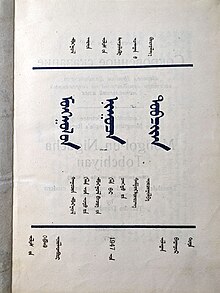
Back التاريخ السري للمغول Arabic Тайная гісторыя манголаў Byelorussian Тайна история на монголите Bulgarian Història secreta dels mongols Catalan Tajná kronika Mongolů Czech Монголсен хĕвшухăшла каланăлăхĕ CV Die Geheime Geschichte der Mongolen German La sekreta historio de la Mongoloj Esperanto Historia secreta de los mongoles Spanish تاریخ سری مغولان Persian
 1947 edition in modern Mongolian script, translated by Tsendiin Damdinsüren | |
| Author | Unknown |
|---|---|
| Original title | ᠮᠣᠩᠭᠣᠯ ᠤᠨ ᠨᠢᠭᠤᠴᠠ ᠲᠣᠪᠴᠢᠶᠠᠨ |
| Language | Middle Mongolian |
| Subject | History of the Mongol Empire |
Publication date | Year of the Rat in the 13th century (c. 1228/1229, 1240, 1252, 1264) |
| Publication place | Mongol Empire |
The Secret History of the Mongols (Mongolian: ᠮᠣᠩᠭᠣᠯ ᠤᠨ
ᠨᠢᠭᠤᠴᠠ
ᠲᠣᠪᠴᠢᠶᠠᠨ [ˌmɔɴɢɜˈɮʲiːɴ ˈnuːt͡sʰ ˌtʰɞɸˈt͡ɕʰɔː], Khalkha Mongolian: Монголын нууц товчоо, Mongolyn nuuts tovchoo) is the oldest surviving literary work in the Mongolian language. Written for the Mongol royal family some time after the death of Genghis Khan in 1227, it recounts his life and conquests, and partially the reign of his successor Ögedei Khan.
The author is unknown and wrote in the Middle Mongol language using Mongolian script. The date of the text is uncertain, as the colophon to the text describes the book as having been finished in the Year of the Mouse, on the banks of the Kherlen River at Khodoe Aral, corresponding to an earliest possible figure of 1228.[1]
While the Secret History was preserved in part as the basis for a number of chronicles such as the Jami' al-tawarikh, Shengwu qinzheng lu, and Altan Tobchi, the full Mongolian body only survived from a version made around the 1400s at the start of the Ming dynasty, where the pronunciation was transcribed into Chinese characters as a tool to help interpreters[1] under the title The Secret History of the Yuan Dynasty (Chinese: 元朝秘史; pinyin: Yuáncháo Mìshǐ). About two-thirds of the Secret History also appear in slightly different versions in the 17th-century Mongolian chronicle Altan Tobchi (lit. 'Golden Chronicle') by Lubsang-Danzin.
The Secret History is regarded as the single most significant native Mongolian account of Genghis Khan. Linguistically, it provides the richest source of pre-Classical Mongol and Middle Mongol.[2] The Secret History is regarded as a piece of classic literature in both Mongolia and the rest of the world, and has been translated into more than 40 languages.[3]
- ^ a b The Secret History of the Mongols. Penguin Classics. Translated by Atwood, Christopher Pratt. Dublin: Penguin Books. 2023. ISBN 978-0-241-19791-2.
- ^ Rachewiltz, Igor de (2004). Secret History of the Mongols: A Mongolian Epic Chronicle of the Thirteenth Century. Brill. p. xxvi. ISBN 978-90-04-13159-0.
- ^ "Г.Билгүүдэй: "Монголын нууц товчоо"-г 30 гаруй оронд, 40 гаруй хэл рүү орчуулсан". www.unuudur.mn (in Mongolian). 2023-07-28. Retrieved 2023-12-10.